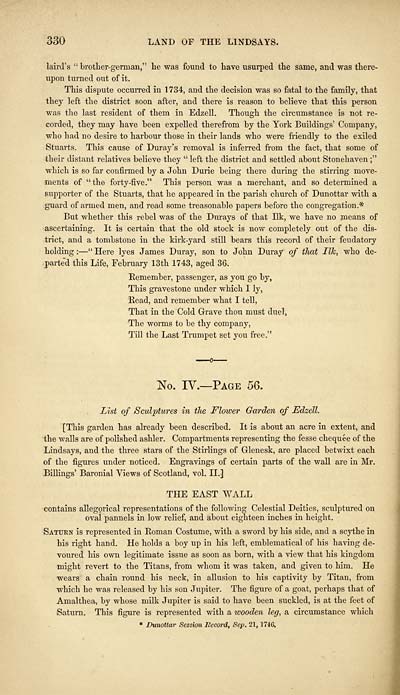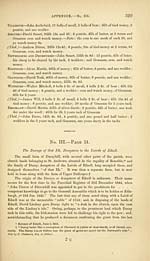Download files
Complete book:
Individual page:
Thumbnail gallery: Grid view | List view

330 LAND OF THE LINDSAYS.
laird's " brothergernian," lie was found to have usurped the same, and was there-
upon turned out of it.
This dispute occurred in 1734, and the decision was so fatal to the family, that
they left the district soon after, and there is reason to believe that this person
was the last resident of them in Edzell. Though the circumstance is not re-
corded, they may have been expelled therefrom by the York Buildings' Company,
who had no desire to harbour those in their lands who were friendly to the exiled
Stuarts. This cause of Duray's removal is inferred from the fact, that some of
their distant relatives believe they " left the district and settled about Stonehaven ;"
which is so far confirmed by a John Durie being there during the stirring move-
ments of "the forty-five." This person was a merchant, and so determined a
supporter of the Stuarts, that he appeared in the parish church of Dunottar with a
guard of armed men, and read some treasonable papers before the congregation.*
But whether this rebel was of the Durays of that Ilk, we have no means of
ascertaining. It is certain that the old stock is now completely out of the dis-
trict, and a tombstone in the kirk-yard still bears this record of their feudatory
holding : — " Here lyes James Duray, son to John Duray of that ITk, who de-
parted this Life, February 13th 1743, aged 36.
Remember, passenger, as you go by,
This gravestone under which I ly,
Read, and remember what I tell,
That in the "Cold Grave thou must duel,
The worms to be thy company,
Till the Last Trumpet set you free."
No. IV.— Page 56.
List of Sculptures in the Flower Garden of Edzell.
[This garden has already been described. It is about an acre in extent, and
the walls are of polished ashler. Compartments representing the fesse chequee of the
Lindsays, and the three stars of the Stirrings of Glenesk, are placed betwixt each
of the figures under noticed. Engravings of certain parts of the wall are in Mr.
Billings' Baronial Views of Scotland, vol. II.]
THE EAST WALL
contains allegorical representations of the following Celestial Deities, sculptured on
oval pannels in low relief, and about eighteen inches in height.
Saturn is represented in Roman Costume, with a sword by his side, and a scythe in
his right hand. He holds a boy up in his left, emblematical of his having de-
voured his own legitimate issue as soon as born, with a view that his kingdom
might revert to the Titans, from whom it was taken, and given to him. He
wears a chain round his neck, in allusion to his captivity by Titan, from
which he was released by his son Jupiter. The figure of a goat, perhaps that of
Amalthea, by whose milk Jupiter is said to have been suckled, is at the feet of
Saturn. This figure is represented with a wooden leg, a circumstance which
* Dunottar Session Record, Sep. 21, 174G,
laird's " brothergernian," lie was found to have usurped the same, and was there-
upon turned out of it.
This dispute occurred in 1734, and the decision was so fatal to the family, that
they left the district soon after, and there is reason to believe that this person
was the last resident of them in Edzell. Though the circumstance is not re-
corded, they may have been expelled therefrom by the York Buildings' Company,
who had no desire to harbour those in their lands who were friendly to the exiled
Stuarts. This cause of Duray's removal is inferred from the fact, that some of
their distant relatives believe they " left the district and settled about Stonehaven ;"
which is so far confirmed by a John Durie being there during the stirring move-
ments of "the forty-five." This person was a merchant, and so determined a
supporter of the Stuarts, that he appeared in the parish church of Dunottar with a
guard of armed men, and read some treasonable papers before the congregation.*
But whether this rebel was of the Durays of that Ilk, we have no means of
ascertaining. It is certain that the old stock is now completely out of the dis-
trict, and a tombstone in the kirk-yard still bears this record of their feudatory
holding : — " Here lyes James Duray, son to John Duray of that ITk, who de-
parted this Life, February 13th 1743, aged 36.
Remember, passenger, as you go by,
This gravestone under which I ly,
Read, and remember what I tell,
That in the "Cold Grave thou must duel,
The worms to be thy company,
Till the Last Trumpet set you free."
No. IV.— Page 56.
List of Sculptures in the Flower Garden of Edzell.
[This garden has already been described. It is about an acre in extent, and
the walls are of polished ashler. Compartments representing the fesse chequee of the
Lindsays, and the three stars of the Stirrings of Glenesk, are placed betwixt each
of the figures under noticed. Engravings of certain parts of the wall are in Mr.
Billings' Baronial Views of Scotland, vol. II.]
THE EAST WALL
contains allegorical representations of the following Celestial Deities, sculptured on
oval pannels in low relief, and about eighteen inches in height.
Saturn is represented in Roman Costume, with a sword by his side, and a scythe in
his right hand. He holds a boy up in his left, emblematical of his having de-
voured his own legitimate issue as soon as born, with a view that his kingdom
might revert to the Titans, from whom it was taken, and given to him. He
wears a chain round his neck, in allusion to his captivity by Titan, from
which he was released by his son Jupiter. The figure of a goat, perhaps that of
Amalthea, by whose milk Jupiter is said to have been suckled, is at the feet of
Saturn. This figure is represented with a wooden leg, a circumstance which
* Dunottar Session Record, Sep. 21, 174G,
Set display mode to:
![]() Universal Viewer |
Universal Viewer | ![]() Mirador |
Large image | Transcription
Mirador |
Large image | Transcription
Images and transcriptions on this page, including medium image downloads, may be used under the Creative Commons Attribution 4.0 International Licence unless otherwise stated. ![]()
| Histories of Scottish families > History and traditions of the land of the Lindsays in Angus and Mearns > (348) Page 330 |
|---|
| Permanent URL | https://digital.nls.uk/94873202 |
|---|
| Description | A selection of almost 400 printed items relating to the history of Scottish families, mostly dating from the 19th and early 20th centuries. Includes memoirs, genealogies and clan histories, with a few produced by emigrant families. The earliest family history goes back to AD 916. |
|---|

